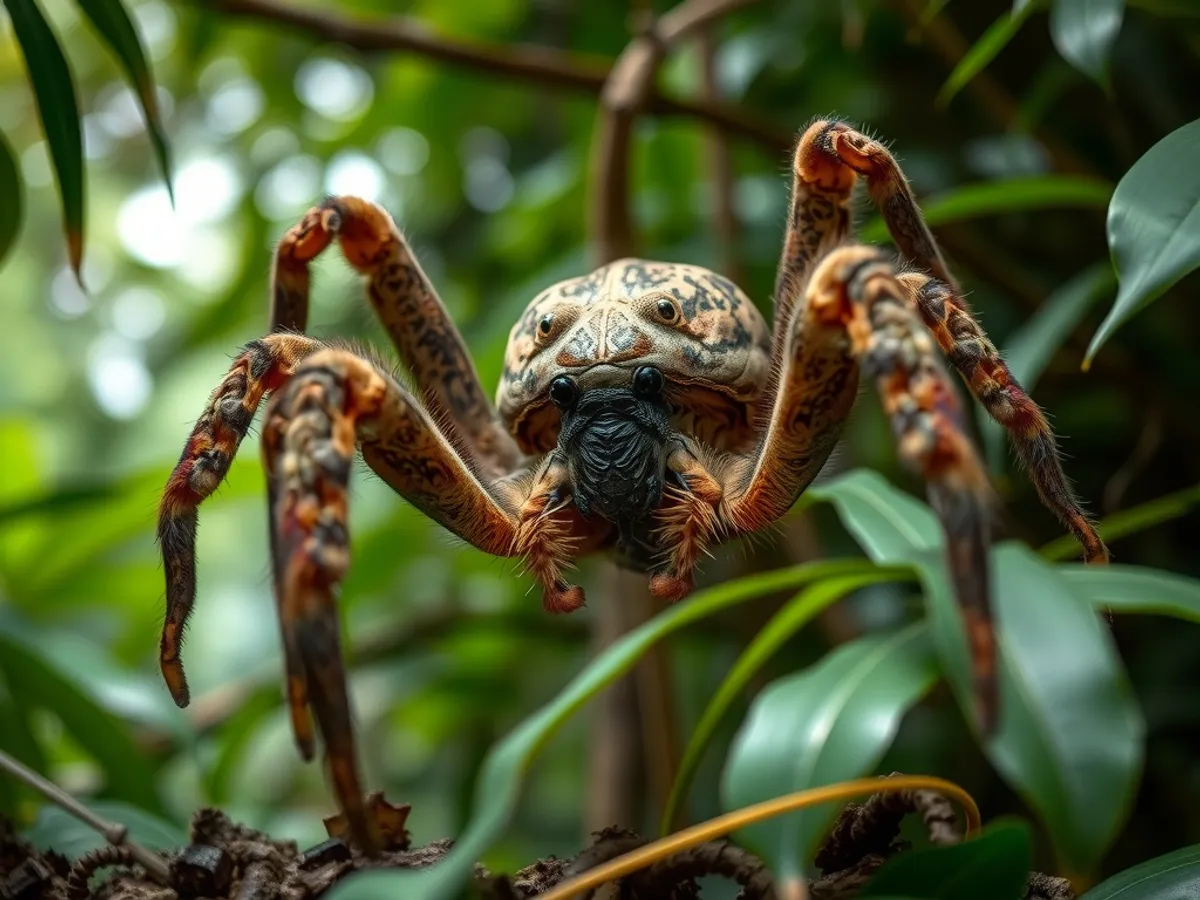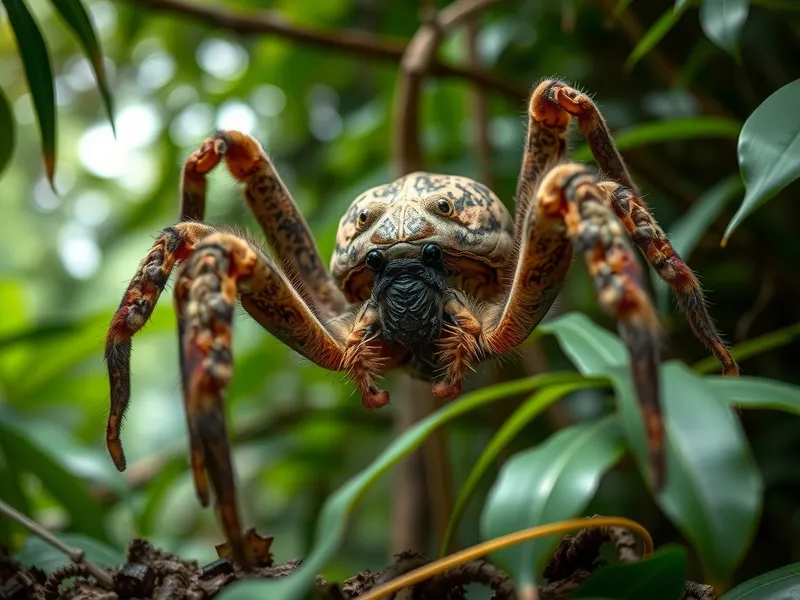
Goliath Birdeater
Theraphosa blondi

Meet the Goliath Birdeater
The Goliath Birdeater is the largest spider in the world by mass and size, native to the rainforests of northern South America. Despite its name, it rarely preys on birds, instead feeding on insects, small mammals, amphibians, and occasionally invertebrates. Its body can reach up to 13 cm (5.1 in) in length, with a leg span of up to 30 cm (12 in) and a weight of over 170 grams (6 oz). The Goliath Birdeater is known for its impressive size, urticating hairs for defense, and its ability to produce a hissing sound when threatened.
Classification
Invertebrate
Habitat
Tropical rainforest
Diet
Carnivore
Lifespan
10-15 years (females), 3-6 years (males)
Conservation
Least Concern
Weight
100-175 grams
📖Fascinating Facts
Largest Spider
The Goliath Birdeater holds the record as the largest spider in the world by mass and size, although some tarantulas have longer leg spans.
Rainforest Resident
This spider dwells primarily in deep burrows on the forest floor of South American rainforests, especially in Venezuela, Suriname, Guyana, and northern Brazil.
Diverse Diet
Despite its name, the Goliath Birdeater rarely eats birds; its diet mainly consists of insects, worms, frogs, and small rodents.
📋Detailed Description
The Goliath Birdeater (Theraphosa blondi) is the largest spider in the world by mass, with adult females typically weighing between 120 and 175 grams and possessing a leg span that can reach up to 30 cm (12 in). Its robust, hairy body is generally a deep brown to light tan, with dense setae (hairs) covering the legs and abdomen. The chelicerae (fangs) are powerful and can reach up to 2.5 cm (1 in) in length, enabling the spider to subdue a wide range of prey. T. blondi is a terrestrial, nocturnal species, spending most of its life in deep burrows that it excavates or occupies, often in swampy or marshy areas of the Amazon rainforest. The species is solitary, exhibiting aggressive territorial behaviors, especially among females. When threatened, it employs a range of defenses, including stridulation (producing a hissing sound by rubbing leg bristles), rearing up to display its fangs, and flicking urticating hairs from its abdomen, which can cause irritation to predators and humans. Its diet is highly opportunistic, including insects, earthworms, amphibians, small rodents, and occasionally small birds, though avian prey is rare. The Goliath Birdeater has a lifespan of 15–25 years in females, while males typically live only 3–6 years, dying soon after reaching sexual maturity. Its molting process is critical for growth and regeneration, allowing the spider to replace lost limbs and repair damage.
💡 Did you know?
The Goliath Birdeater's fangs can be up to 2.5 cm (1 in) long—strong enough to pierce a mouse's skull.
🔬Research & Sources
Wikipedia Summary
The Goliath birdeater belongs to the tarantula family Theraphosidae. Found in northern South America, it is the largest spider in the world by mass and body length, and second to the giant huntsman spider by leg span. It is also called the Goliath tarantula or Goliath bird-eating spider; the practice of calling theraphosids "bird-eating" derives from an early 18th-century copper engraving by Maria Sibylla Merian that shows one eating a hummingbird. Despite the spider's name, it rarely preys on birds.
Last Modified: 6/3/2025
🎭Behavior & Social Structure
Goliath Birdeaters are primarily nocturnal ambush predators, relying on stealth and their sensitive setae to detect vibrations and movements of prey. They rarely leave their burrows except to hunt or during the mating season. When hunting, they wait at the entrance of their burrow and lunge at passing prey, injecting venom to immobilize it before secreting digestive enzymes to liquefy tissues. Social interactions are minimal, with individuals aggressively defending their territory from conspecifics. Defensive behaviors include stridulation (a hissing noise produced by rubbing specialized bristles on the legs), threat postures, and the release of urticating hairs. These spiders are generally sedentary, spending long periods in their burrows, emerging mainly during humid nights when prey is abundant. They are known to occasionally cannibalize smaller individuals, especially during periods of food scarcity.
👶Reproduction & Life Cycle
Reproduction in T. blondi occurs during the rainy season, typically from May to August. Males reach maturity at 3–6 years and leave their burrows in search of females, guided by pheromones. Courtship involves leg tapping and cautious approach, as females may attack or cannibalize males. If successful, the male deposits a sperm web and transfers sperm to the female using his pedipalps. Females lay between 100 and 200 eggs in a silken sac, which they guard aggressively within their burrow. Incubation lasts 6–8 weeks, after which spiderlings emerge and remain in the maternal burrow for several days before dispersing. There is no further parental care after dispersal. Sexual dimorphism is pronounced, with females being larger and longer-lived than males.
🛡️Adaptations & Survival
The Goliath Birdeater exhibits several adaptations for survival in the rainforest floor environment. Its large size and powerful fangs allow it to tackle a wide range of prey, while its cryptic coloration provides camouflage among leaf litter. The spider’s urticating hairs are a key defensive adaptation, causing irritation or allergic reactions in potential predators. Stridulation serves as both a warning and a deterrent. The species’ burrowing behavior offers protection from predators and environmental extremes, while nocturnality reduces competition and predation risk. The ability to regenerate lost limbs during molting is an important evolutionary trait, enhancing survival after injury.
🎨Cultural Significance
The Goliath Birdeater has fascinated humans for centuries, featuring in indigenous folklore as both a symbol of fear and respect. The term 'bird-eating spider' originated from an 18th-century illustration by Maria Sibylla Merian, though actual bird predation is rare. In some Amazonian cultures, the spider is used in traditional medicine or as a source of protein, with roasted spiders considered a delicacy. In Western culture, it is often portrayed in media and popular science as a symbol of the exotic and formidable wildlife of the Amazon. Its impressive size and defensive behaviors have made it a popular, though challenging, species in the exotic pet trade.
🔬Recent Research & Discoveries
Recent research has focused on the composition and potential medical applications of T. blondi venom, which contains a complex mixture of proteins and peptides with cytolytic and neurotoxic properties. Studies have also examined the ecological role of the species as a top invertebrate predator in the rainforest floor ecosystem. Advances in molecular phylogenetics have clarified the relationships within the Theraphosa genus, and ongoing field studies are investigating the impact of habitat fragmentation on population genetics. There is growing interest in the spider’s urticating hairs as a model for bioinspired materials due to their unique structure and defensive efficacy.
🎥Wildlife Videos

The Biggest Spider on the Planet | Bite, Sting, Kill
#NatGeoWILD #Spiders #BiteStingKill About Bite, Sting, Kill: Bite, Sting, Kill is exploring the ways animals can kill with venom.
Nat Geo Animals

Holding a Wild Goliath Tarantula | Deadly 60 | BBC Earth Explore
Deadly 60: Steve Backshall and his team track down some of the world's deadliest animals. From lethal beauties to killer beasts, ...
BBC Earth Explore

The Goliath Bird Eating Tarantula - biggest spider on earth
In the jungles of Guyana lives the largest Giant spider on planet Earth, the Goliath bird eating tarantula.
Steve Backshall

Tarantula 🕷️ | Amazing Animals
About Amazing Animals: Amazing Animals is a series that profiles a different animal in each episode. These short, one-minute ...
Nat Geo Kids

Goliath Birdeater in Rewa
Most people have a fear of spiders... We wonder how they'll feel about the Goliath Birdeater... Catch a glimpse of this ...
REEL Guyana

TARANTULAS MISUNDERSTOOD - tarantula documentary
The tarantula is one of the most intimidating creatures on earth, but this docu-series proves that they are a misunderstood animal, ...
robbies talking ts
🌍Habitat Information
The Goliath Birdeater typically inhabits Tropical rainforest environments. Goliath Birdeaters have adapted to their environments with specialized features and behaviors.
Primary Habitat:
Tropical rainforest
More detailed habitat information will be available soon.
🛡️Conservation Status
The Goliath Birdeater is currently classified as Least Concern. Conservation efforts are crucial for preserving this species for future generations.
Common Threats:
- 🏠Habitat loss and fragmentation
- 🌡️Climate change impacts
- 🎯Hunting and poaching
- 🏭Human-wildlife conflict
⚠️Threats & Conservation Challenges
Currently classified as Least Concern, the Goliath Birdeater faces localized threats from habitat destruction due to deforestation, mining, and agricultural expansion in the Amazon basin. Collection for the exotic pet trade poses additional pressure on wild populations, though the impact is not fully quantified. Natural predators include coatis, large centipedes, and some birds of prey. Climate change and habitat fragmentation may pose future risks by altering rainforest microhabitats. Despite these challenges, the species remains relatively widespread and resilient, but ongoing habitat loss could threaten local populations.
🔬Scientific Classification
Scientific Name
Theraphosa blondi
Classification Hierarchy
🔍 About Taxonomic Classification
Taxonomic classification is a hierarchical system used by scientists to classify and organize living organisms based on shared characteristics and evolutionary relationships.
The system moves from broad categories (Kingdom) to increasingly specific ones, with each animal's scientific name typically consisting of its Genus and species.
📝Community Notes
Share your observations and insights about the Goliath Birdeater with our community of wildlife enthusiasts.
Join Our Community
Sign in to share your observations and connect with fellow wildlife enthusiasts.
Sign In to ContributeNo community notes yet
Be the first to share your observations about the Goliath Birdeater!
Explore Goliath Birdeater
Select a tab above to learn more about this amazing animal.
📸Photo Gallery
No photos available for this animal yet.
🌟Discover More Wildlife
Continue your journey of discovery with more fascinating animals from our database
